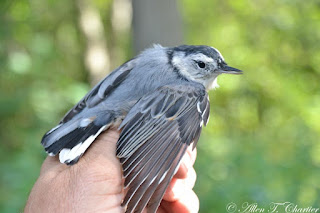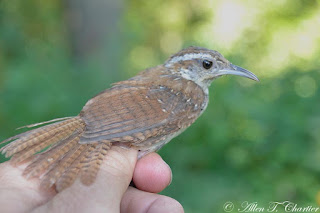I have been behind in many things since spring, so this posting describing the season opening of the fall banding station at Metro Beach (Lake St. Clair Metropark, St. Clair Co., Michigan) covers activities over the past two weeks - 4 days of banding. Hopefully I'll be able to keep up on a weekly basis from now on.
We began the season on Sunday, August 5 with the usual later start because the main task is getting the net lanes cleared and the nets getting properly placed for the first time since spring. Despite the drought over the summer, the vegetation was thick and more than waist high, so it took quite a bit of weed whacking to get it all cleared. Also, three areas were affected by tree falls over the summer so had to be hand-sawed to clear them out of the way. The volunteers today deserve a lot of credit, as they worked very hard. Just when we finished all this, it started to rain! Ironic after so long this without any. But it only rained for about an hour, so after it stopped we got the nets located, and were able to keep them open for 3 1/2 hours and catch the first birds of the fall season. On Thursday, August 9, we arrived in the park at our usual 5 a.m. (E.S.T.) and got the nets set up quickly. But a little more than an hour after the last (of 13.5) nets were open, it started to rain! The birds from the last net run, which included some of the first migrants of the season, were banded under the shelter of my car's hatchback and we waited for a chance to open the nets back up. After 3 hours, it was clear that re-opening wasn't going to happen, so we were then hoping for the rain to lighten up a bit so we could take the nets down without too much discomfort. That didn't happen either, so we took the soaked nets down, and everyone got completely drenched. Well, we really DO need the rain! Sunday, August 12 was the first "normal" day of the season with the nets open for a full day (6 hours after the last nets are open), and no rain. On Thursday, August 16, the day started out well but increasing winds (an impending rain that never materialized) forced us to close about an hour earlier than normal. But given how few birds were caught today, we really didn't mind.
Many thanks to the banding volunteers who helped on these four days. They are listed below under the days they volunteered.
Highlights of the 7 birds banded on Sunday, August 5 included the first Ruby-throated Hummingbird of the fall season, a hatch-year male that was almost certainly a migrant. Another species that does breed in the banding area but is infrequently captured is the Eastern Wood-Pewee. It was very exciting to find that the one caught today was already banded, at this location in 2009. When banded, she was showing a very extensive brood patch so was determined to be a female. Males also get brood patches in flycatchers, so only those showing a wide and very vascularized patch are sexed female.
 |
| After hatch-year female Eastern Wood-Pewee |
More expected were juveniles of locally breeding species, like this Common Yellowthroat which was actually the first bird captured and banded for the fall season. Characteristics of juvenile yellowthroats include a lack of yellow on the throat (!), and cinnamon wing bars.
 |
| Hatch-year Common Yellowthroat |
Song Sparrows appear to have had a good nesting season and the first juvenile of the fall was captured today too. Lacking a central breast spot, they can be easily confused this time of year with juvenile Swamp Sparrows, which are also heavily streaked below (which they lose sometime in their spring molt).
 |
| Hatch-year Song Sparrow |
Interesting birds observed but not banded included an American Woodcock flushed from near the Swamp Nets, a flock of 9 Eastern Kingbirds chasing a Cooper's Hawk, and a singing Red-eyed Vireo.
Highlights of the 25 birds banded on Thursday, August 9 included a very nice array of migrants on the third (and last) net run of the day. Willow Flycatcher nests in the banding area (and sometimes Alder), but they also migrate early so it is difficult to know their status in early August. The individual below was an adult that was molting, so possibly was not a migrant as they are presumed to finish their molt before departing.
 |
| After hatch-year Willow Flycatcher |
The arrival of warblers breeding north of the banding area are always anticipated through the month of August, with the first big push usually occurring the last week, but typically some early migrants begin moving earlier, as they did today. It was frustrating to have to close the nets so early because of the rain, as we may have caught quite a few more. The first warbler in the net, actually getting caught just after we finished setting up the Upland Nets, was a Black-and-white Warbler.
 |
| Hatch-year male Black-and-white Warbler |
In the very same net, almost in exactly the same spot, on the next net run was a species that is typically only an early migrant, a Mourning Warbler.
 |
| Hatch-year Mourning Warbler |
Another migrant warbler that often turns up early, but also later, is the Northern Waterthrush.
 |
| Hatch-year Northern Waterthrush |
And yet another early migrant, one which is sometimes missed entirely at this banding station, is the Blackburnian Warbler.
 |
| Hatch-year male Blackburnian Warbler |
It is never certain that we'll catch any Yellow Warblers in August, which is a common nesting species in the banding area, because they seem to peak in their migration in late July. There were a few left this year, and two hatch-years were banded today (one below), and a molting adult that had been banded this spring was also recaptured.
 |
| Hatch-year Yellow Warbler |
A colorful surprise was an adult male Indigo Bunting. This species is not banded every year at this station, and in fall the males molt into a drabber female-like plumage. But this bird was in fine feather!
 |
| After second-year male Indigo Bunting |
And finally, I always hope to catch a few Baltimore Orioles before they depart, which is usually before mid-September. Today we were happy to have three of them.
 |
| Hatch-year female Baltimore Oriole |
Interesting birds observed but not banded included an American Woodcock again, this time flushed just over one of the nets, and a singing Carolina Wren.
Highlights of the 44 birds banded on Sunday, August 12 included 4 Ruby-throated Hummingbirds. The big surprise was a second-year female Hermit Thrush. This species nests more than 100 miles north of the banding area, and is typically the last species to arrive in migration in mid-September (Swainson's are more expected in early August). The earliest Hermit Thrush that has ever been banded here before is September 4, a very spotty juvenile.
 |
| Second-year female Hermit Thrush |
It is also very unusual to be able to age a Hermit Thrush as a second-year in the fall (this is the first one at this station), but this bird was clearly retaining some very worn juvenile inner secondary coverts, while the outer coverts were missing due to molt.
 |
| Second-year female Hermit Thrush |
And never before has a Hermit Thrush been sexed at this locale due to the distance from the breeding grounds. But this bird was showing an extensive and very vascularized brood patch, typical of what it would show in mid-summer!
 |
| Second-year female Hermit Thrush |
More expected was this hatch-year male Northern Cardinal, showing a dusky bill typical of juveniles, and incoming patches of red allowing his sex to be determined.
 |
| Hatch-year male Northern Cardinal |
And a potentially confusing sparrow, a juvenile Swamp Sparrow. Compare with the juvenile Song Sparrow above.
 |
| Hatch-year Swamp Sparrow |
Interesting birds observed but not banded included a flyover Belted Kingfisher, a Red-breasted Nuthatch, Carolina Wren, a Marsh Wren, and two Blue-gray Gnatcatcher.
Highlights of the 11 birds banded on Thursday, August 16 were very few. The best I can do for this day is a photo of a Ruby-throated Hummingbird.
 |
| Hatch-year female Ruby-throated Hummingbird |
Interesting birds observed but not banded included flyover Green Heron and Belted Kingfisher, and a briefly calling Great Crested Flycatcher.
============================
Banding Data
----------------------------
SUNDAY, August 5, 2012
Sunrise (E.S.T.): 5:27
Time Open (E.S.T.): 10:30
Time Closed (E.S.T.): 14:00
Hours Open: 3.5
No. of Nets: 4.5-13.5
Net Hours: 40.25
Temperature (F): 73-86
Cloud Cover: 80-30%
Wind: SW @ 5-7-10 mph
Barometer: 29.93-29.98
Precipitation: None (rain from 8:45 - 10:00)
No. Banded: 7 (plus 2 recaptured)
No. of Species: 5
Capture Rate: 22.4 birds per 100 net hours
Volunteers (worked 9.50 hours, 6:00-15:30): Rebecca Blundell, Stevie Kuroda, Michelle Serreyn (2.5 hrs), Joan Tisdale, Bruce Watson.
Ruby-throated Hummingbird - 1
[Eastern Wood-Pewee - 1 recaptured]
American Robin - 3
Common Yellowthroat - 2
Song Sparrow - 1 (plus 1 recaptured)
-------------------------------------
THURSDAY, August 9, 2012
Sunrise (E.S.T.): 5:32
Time Open (E.S.T.): 5:45
Time Closed (E.S.T.): 8:00 (rain forced early close)
Hours Open: 2.25
No. of Nets: 4.5-13.5
Net Hours: 23.375
Temperature (F): 68-64
Cloud Cover: 100%
Wind: NNW-ENE @ 5-7 mph
Barometer: 29.98
Precipitation: Rain from 8:00 - 14:00+
No. Banded: 25 (plus 3 recaptured)
No. of Species: 15
Capture Rate: 119.8 birds per 100 net hours
Volunteers (worked 9.0 hours, 5:00-14:00): Rebecca Blundell, Tom Schlack, Blanche Wicke.
Eastern Wood-Pewee - 1
Willow Flycatcher - 2
"Traill's" Flycatcher - 2
Least Flycatcher - 1
American Robin - 1
Yellow Warbler - 2 (plus 1 recaptured)
Blackburnian Warbler - 1
Black-and-white Warbler - 1
Northern Waterthrush - 1
Mourning Warbler - 1
Common Yellowthroat - 3 (plus 2 recaptured)
Song Sparrow - 3
Swamp Sparrow - 1
Indigo Bunting - 1
Baltimore Oriole - 3
American Goldfinch - 1
-------------------------------------
SUNDAY, August 12, 2012
Sunrise (E.S.T.): 5:35
Time Open (E.S.T.): 5:45
Time Closed (E.S.T.): 12:45
Hours Open: 7.00
No. of Nets: 4.5-13.5
Net Hours: 84.25
Temperature (F): 64-75
Cloud Cover: 50-90-20%
Wind: WNW @ 3-5 mph
Barometer: 29.98-30.00
Precipitation: None
No. Banded: 44 (plus 2 recaptured and 1 released unbanded)
No. of Species: 12
Capture Rate: 55.8 birds per 100 net hours
Volunteers (worked 9.5 hours, 5:00-14:30): Rebecca Blundell, Chris Charlebois (1.0 hr), Jacob Charlebois (1.0 hr), Stevie Kuroda, Joan Tisdale, Bruce Watson.
Ruby-throated Hummingbird - 4
Willow Flycatcher - 1
"Traill's" Flycatcher - 2
Least Flycatcher - 1
House Wren - 4
Hermit Thrush - 1
American Robin - 1
Northern Waterthrush - 1
Common Yellowthroat - 4
Song Sparrow - 14 (plus 1 released unbanded)
Swamp Sparrow - 1
Northern Cardinal - 3
American Goldfinch - 7 (plus 2 recaptured)
-------------------------------------
THURSDAY, August 16, 2012
Sunrise (E.S.T.): 5:39
Time Open (E.S.T.): 5:45
Time Closed (E.S.T.): 11:30 (wind forced early close)
Hours Open: 5.75
No. of Nets: 4.5-13.5
Net Hours: 69.375
Temperature (F): 66-79
Cloud Cover: 90-50-100%
Wind: SSE-SE @ 5-7-15 mph
Barometer: 30.00-29.93
Precipitation: None
No. Banded: 11 (plus 5 recaptured and 1 released unbanded)
No. of Species: 3
Capture Rate: 24.5 birds per 100 net hours
Volunteers (worked 8.0 hours, 5:00-13:00): Rebecca Blundell, Jacob Charlebois, Mike Charlebois (3.5 hrs), Marie McGee, Tom Schlack.
Ruby-throated Hummingbird - 3
Song Sparrow - 2 (plus 3 recaptured and 1 released unbanded)
American Goldfinch - 6 (plus 2 recaptured)






























